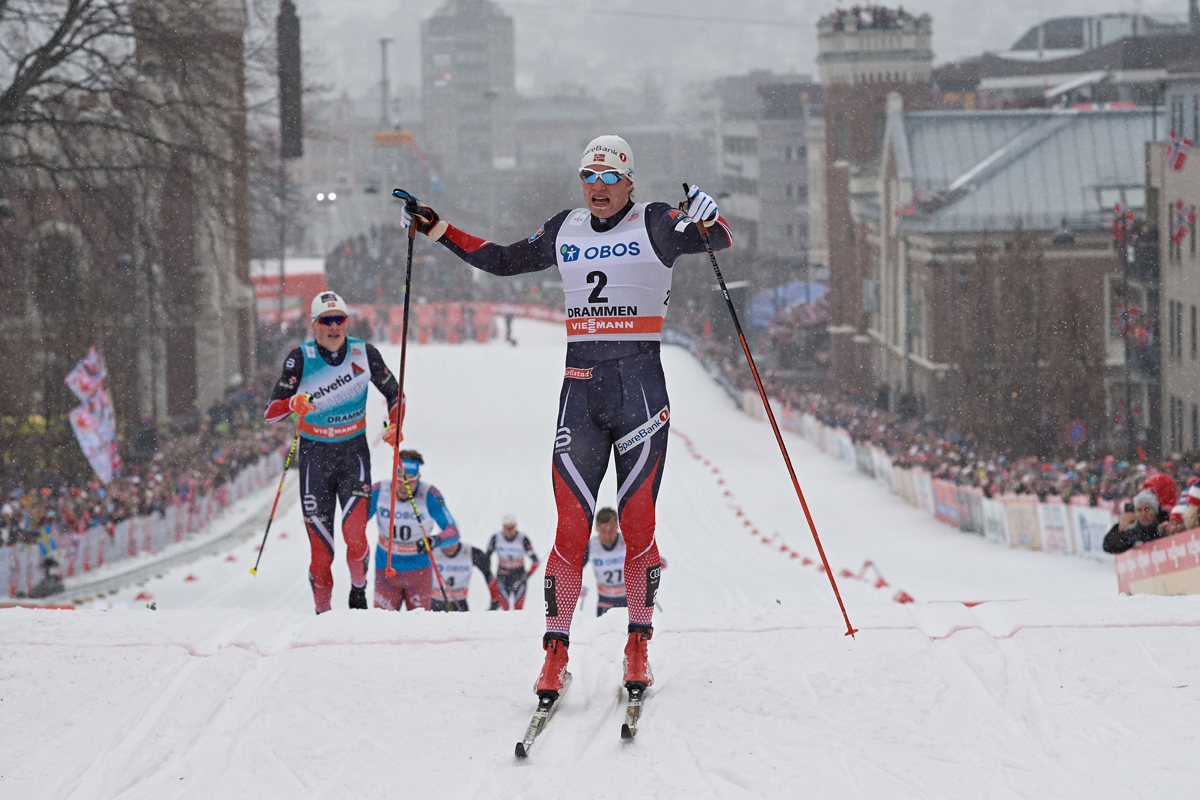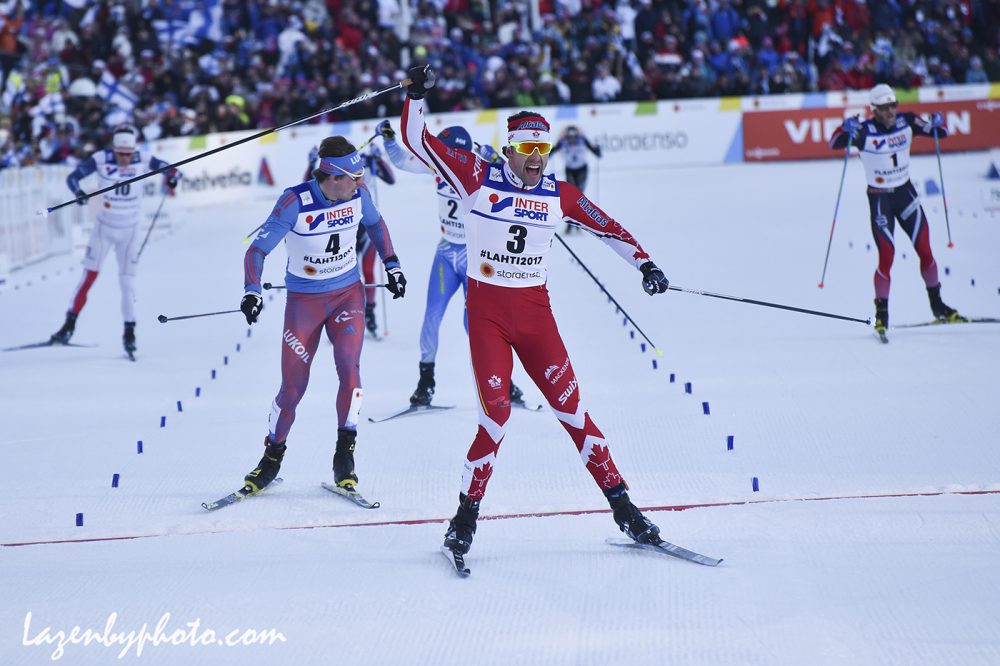
DRAMMEN, Norway — The stage was set around 1:30 p.m. Wednesday when a homegrown Norwegian made good in front of a spectator-lined 1.2-kilometer classic course smack-dab in the middle of Drammen’s city center. It was a day of contrast that began with blue skies and ended with a deep chill and falling snow as thumping music pounded and the gothic Bragernes Church loomed. In between, the clouds amassed and the classic tracks stayed firmed for the Drammen city sprint.
As the host country, Norway was blessed with more skier starts for the midweek World Cup sprint. That, however, looked like a curse for every other nation competing. Thirty-three percent of the eventual top 30 finishers were from Norway — 10 out of 30 — and five of six in the final. We’ll get to that in a bit.
The qualifier was owned in every sense of the word by Norway’s 20-year-old Johannes Høsflot Klæbo. He was first in the qualifier by what some may consider a whopping 3.62 seconds. He stopped the clock at 2:33.81. around the one-loop course, which went up, then down again, and then up again. Klæbo’s Norwegian teammate Eirik Brandsdal was second in the qualifier with a time of 2:37.43.
And if that time margin wasn’t a stunner, consider this. The day also marked the first time a World Cup sprint included two no-double-pole (DP) zones. During his qualifier, Klæbo came out of the first no-DP zone and stumbled, momentarily looking as if he was about to fall. His iconoclastic high-tempo, run-ski up steep hills is already a winning trademark, but in this instance it almost doomed him.
That, of course, didn’t happen — he cruised in cool if not for his furious speed.
All of this set the young Norwegian up for stardom. The World Cup’s season-long U23 leader came into Drammen ranked second overall on the World Cup sprint list with 289 points, just behind Italy’s Federico Pellegrino with 309 points. Pellegrino placed 12th on Wednesday, while Klæbo advanced to the finals.
But perhaps the principle animator on the day was none other than Norway’s Petter Northug. After qualifying 27th, Northug looked rejuvenated in the first quarterfinal. Coming up the gradual mostly double-pole-able climb to finish, it was a Northug double-pole drag race in which he began the grind in sixth. In his famous fashion, he pulled away from the field, crossed the line, then U-turned in front of the oncoming skiers and chest-thumped. It was a throwback to his earlier dominance. And yes, the fans drank from the Northug Kool-Aid.
Northug eventually advanced to the final as the second lucky loser after placing fourth in his semifinal, 3 seconds behind Klæbo, who won that heat.
Another skier to make the final was Norway’s two-time Drammen classic-sprint winner, Brandsdal. His 2015 Drammen win was his last World Cup victory.

Recall that Wednesday’s race was one of contrast. There was the upstart Klæbo. There was Northug’s theatrics. And there was Brandsdal’s steady state skiing.
He had been second in the qualifier, first in his quarterfinal, second in his semi, and untouchable in a final that featured these four other Norwegians: Klæbo, Northug, Pål Golberg, and Sondre Turvoll Fossli and Russian super-skier Sergey Ustiugov.
Up the everlasting final stretch to the feet of the old Bragernes Church, it was initially a Klæbo-Brandsdal dual. That didn’t last long as Brandsdal closed out hard, winning the day for his third-career Drammen victory. Klæbo placed second (+2.55), and Ustiugov third (+3.28) for the Russian’s seventh-straight podium, including five medals in five races at World Championships. Northug finished fourth (+4.5), Golberg fifth (+5.99), and Fossli sixth (+12.42).

“That was hard,” the 30-year-old Brandsdal told the International Ski Federation (FIS) after. “… It feels good to be back on top of the podium again.”
With his second place and Pellegrino’s stall out in the quarterfinals, Klæbo now leads the sprint standings over the Italian, 369 points to 331.
“I will travel now to Quebec and won’t race Holmenkollen this weekend,” Klæbo told FIS. “I just got the sprint leader’s red bib and I will fight to keep it in Quebec and take the Crystal Globe.”
One World Cup sprint remains: a freestyle sprint to start the three-day World Cup Finals in Quebec City next week.
Sunday’s 50 k world champion Alex Harvey was sprint worthy in Drammen. He finished the day in eighth overall after qualifying 18th, winning his quarterfinal, and taking fourth in his semifinal, 4.41 seconds behind Ustiugov, who won that heat.
“I’ve been feeling good, I mean, I’ve never made the semis here in Drammen so it’s the best race of my life here on this course, so feeling good,” Harvey told FasterSkier after being eliminated in the semifinals.
Now the sport’s king in the World Cup’s longest race, the 50 k, Harvey lamented the Drammen course’s short nature. “It’s short. 2:40 [minutes],” Harvey said. “It’s way too short for me. I need a bit closer to three minutes to be able to do something.”

Prior to the upcoming World Cup Finals, which will be held in Harvey’s hometown March 17-19, the Canadian ranks fourth overall on the World Cup leaderboard, 65 points behind Finland’s Matti Heikkinen in third and 104 points ahead of Sweden’s Marcus Hellner in fifth. Neither raced Wednesday’s sprint.
Asked precisely what he was hunting as the World Cup winds down, the 28-year-old Harvey was succinct.
“The top three overall, for sure,” he said. “This is already a good step forward today, got around 20 points or something like that. I know that especially the races in Quebec are a good format for me. If you’re good in the sprint, I can get a bit of an edge on Heikkinen for the last day, for the pursuit start, and with double points there, it can go pretty fast.”
Also advancing to the quarters for Canada was Len Valjas after qualifying 21st (+7.97). Initially the 28-year-old Valjas looked poised to advance beyond the quarters as he was announced the winner of a photo finish with Russia’s Alexander Bolshunov for second place behind Harvey. But the replay showed a fine line as Valjas appeared to make a gutsy move in the closing meters. The race jury ruled that Valjas obstructed Bolshunov by skirting around and in front of him at the finish, and relegated Valjas to last in the heat for 27th overall.
One American man reached the heats: Andy Newell, who began the day qualifying in 13th (+6.45). The U.S. Ski Team member placed fourth in his quarterfinal, 1.7 seconds behind Brandsdal who won the heat, and did not advance to the semifinals to end up 18th overall.

“I felt good today,” Newell said after, “so it’s a shame not to move on to the final. I really was hoping to do that here, this is one of my favorite sprints. I love this atmosphere here and I love Drammen. It’s definitely one of the hardest sprints, competitive sprints, but for me it’s just really fun. So yeah I’m bummed not to advance … But I am feeling good, so I can’t complain.”
Newell added insight into the no-double-pole zones in play, explaining that he learned of the new rule with little time to spare.
“They have been trying them in Scandinavian Cup races and this is the first time they have ever done it on a World Cup,” he said. “It was weird because they literally told us they would have no-double-pole zones, or striding zones, an hour before qualifications. So a lot of us waxed skate skis that we were going to test in anticipation that it would be a double-pole race, because it’s really good conditions for double-pole now. So that was obviously the end of that.”
Also for the U.S., Simi Hamilton placed 42nd in the qualifier, 1.69 seconds out of the top 30 needed to qualify, but the disqualification of two other skiers for receiving their second yellow card — Norway’s Finn Hågen Krogh and Sweden’s Emil Jönsson — moved Hamilton up to 40th. (Krogh was disqualified after racing in the same semifinal as Harvey, and Jönsson was disqualified in the quarterfinals.) Also for the U.S., Erik Bjornsen (U.S. Ski Team) finished the day in 44th, and Ben Lustgarten (Craftsbury Green Racing Project) 62nd.
Canada’s third skier, Russell Kennedy (Canmore Nordic/Team R.A.D.) was 63rd in his first overseas World Cup race.
Jason Albert
Jason lives in Bend, Ore., and can often be seen chasing his two boys around town. He’s a self-proclaimed audio geek. That all started back in the early 1990s when he convinced a naive public radio editor he should report a story from Alaska’s, Ruth Gorge. Now, Jason’s common companion is his field-recording gear.



